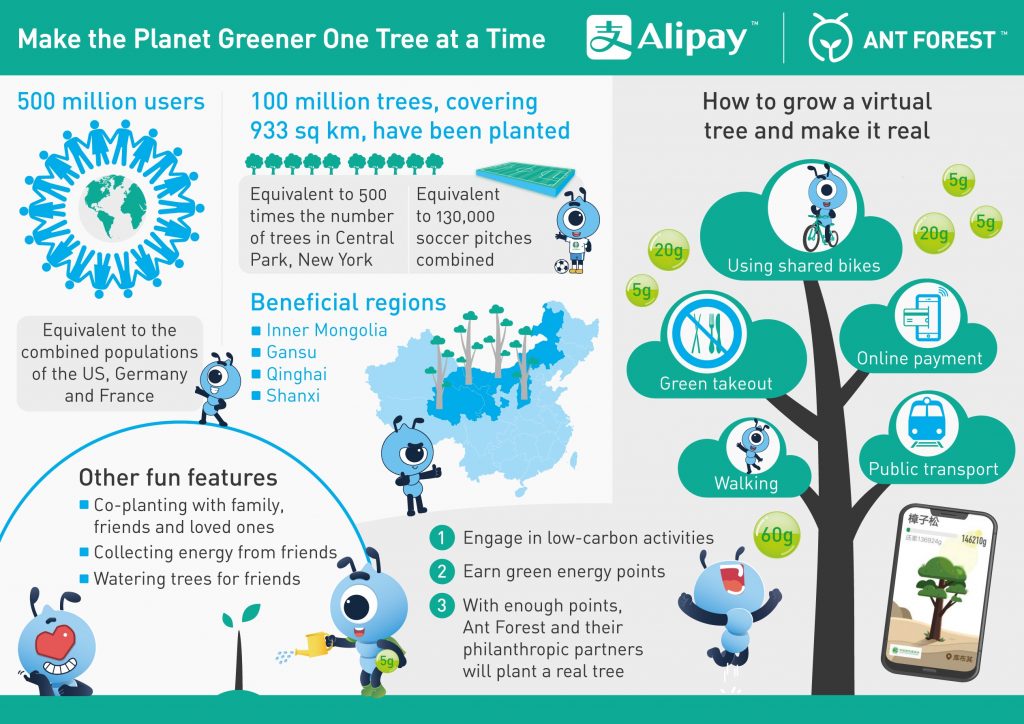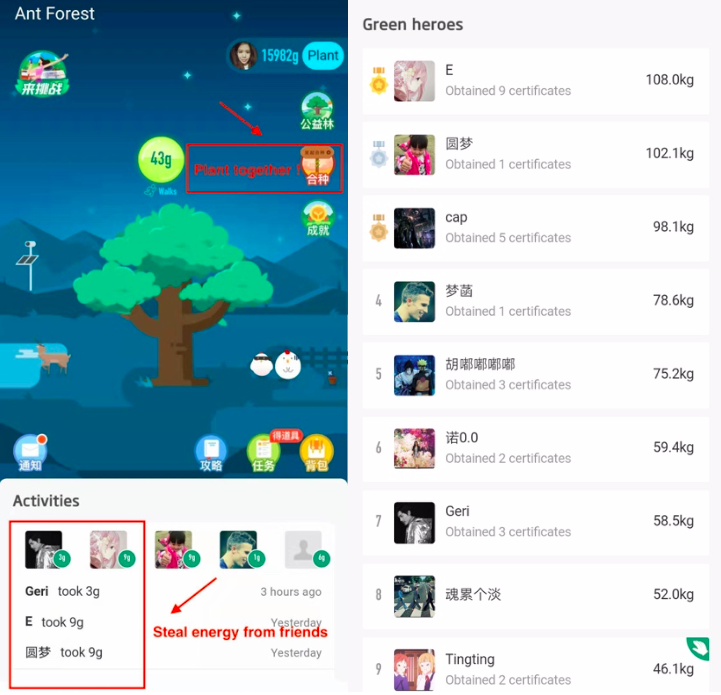Forest at Fingertips – Making Every day an Earth Day!
I can still remember that my high school teacher drives us to the suburb on Arbor Day to plant a tree, spending all day long to teach students a lesson of the importance of environmental protection. We couldn’t imagine in the past that at digital age, everyone can participate in tree-planting activities anytime and anywhere on mobile phones via an online programme called Ant Forest.
Ant Forest is a mini programme embedded in the most popular Chinese mobile payment application Alipay. Some of people may merely consider going green on the Earth Day, but Ant Forest could convert our daily activities such as commuting by public transport, buying second-hand products, paying utilities online and other low-carbon behaviours into virtual “green energy”, with which a virtual tree could be selected online and ultimately a real tree will be planted in Chinese arid area. User can even check the condition of the forest via satellite pictures. The programme has recently won the 2019 Champions of the Earth award (the United Nations’ top environmental honour) on September 19 in inspiration and action category. According to statistics of UN environmental programme, Ant forest and its NGO partners have planted around 122 million trees, covering 112,000 hectares in China’s driest area (unenvironment.org). The “virtual” forest on mobile device is actually changing the way of nature conservation.

(Source: Ant Financial)
Why Emergent? The missing environment in digital era
In many cultures, human and the natural world are not regarded as separate entities, however in today’s society, majority of people still believe there is a clear distinction between them, which makes nature conservation a problem (Nirwan et al. 2). Mol A. found that the environment domain is marginally mentioned in literatures of Information Age (12). The natural environment is rarely associated with digital evolution as driven forces or positive consequences, leading to a huge research gap. It is necessary to investigate the relationship between digital evolution and environmental governance, because digital technology not only inspires new mode of business, communication and governance, it could also change people’s perception and action about nature conservation by engaging daily routine with eco-friendly programme. As “medium shapes and controls the scale and form of human association and action” (McLuhan 9), Ant Forest is such a platform that encourages multiple authorities (include individuals) to participate in collaboration to generate bigger impact.
Digital conservation: via interactive interface and user generated data
The term “digital conservation” is posted by Van der Wal and Arts that refers to the impact and development of digital technology on nature conservation (661). It identified five vital dimensions that have important impact on nature conservation (Picture 3). Here I would like to further discuss how Ant Forest contributes to nature conservation as a digital platform with Arts’ theoretical framework.

First, in terms of data, Ant Forest along with Beijing Environment Exchange (CBEEX) created a “Personal carbon reduction algorithm” to make citizen’s daily activities evaluable. For individual users, the algorithm increases the public awareness of carbon emission, as all low-carbon action will be record by “green energy” points. For example, when people pay their utilities online and get corresponding points, it is more visible how much energy they consume than automatically deducting the fees in their bank account. By interacting with the self-generated data (collect energy points), people might be more aware of their carbon footprints and eco-friendly behaviours. For corporation, they established a new system to calculate personal carbon emission, which is a valuable model for the other countries or company to learn. More importantly, the user-generated data is mainly recorded by online payments, which means Alipay could maintain high customer stickness while gaining great reputation by environmental protection programme.
Relating to data, personal privacy becomes an unavoidable problem. Some users concerned about their information safety on Ant Forest platform, because the “green energy” points may indirectly expose users’ consumption habits and lifestyle, which infringes users’ privacy. To deal with this criticism, Ant Forest allows user to forbid viewing the actual points by others. Even so, how monopolized enterprise utilize our personal data remains further discussion.
Then, the most interesting dimensions are participatory governance and communication strategies. Generally speaking, Ant Forest is an eco-friendly programme appealing to low-carbon actions. However, with its energy ranking system and interface design, it also becomes a popular mini game for interacting with friends. For example, you can corporate with your boyfriend to grow a couple tree together, isn’t it good? Some user even comment that they get up early every morning to collect the “green energy”. It might sound crazy , but it shows the success of Ant Forest in utilizing human nature to maintain and attract users.

Digital technology + green finance = ecological infrastructure?
The operation mode of Ant Forest takes part of responsibility from government departments, combining virtual power with real contribution to the nature. People can live every day an Earth Day without paying extra costs. It has gradually integrated in our social life along with Alipay application. Plantin et al. state that infrastructure refers to sociotechnical systems that are designed in the development of new technologies (295). Ant Forest might also be considered as ecological infrastructure with increasing embeddedness in our daily life.
In article 17 of Kyoto protocol, Emission trading policy is set out among countries, which means in the near future, carbon emission might be as valuable as the other resources (unfccc.int). If digital personal carbon account could be well established under the effort of Ant Forest algorithm, it is possible to construct an economic system for environmental conservation. Nobody knows whether it will lead us to a positive consequence or not, but we could expect the day that technology plus business could bring significant changes to human relationship with our living environment.
Bibliography
Arts, K.A.J., et al. “Digital Technology and the Conservation of Nature.” Ambio, vol. 44, no. 4, 2015, pp. 661–73, doi:10.1007/s13280-015-0705-1.
CGTN. “Come together: Forest at fingertips”. Youtube, 17 Jun. 2019, https://www.youtube.com/watch?v=BoyxPYnVIXA
“Chinese initiative Ant Forest wins UN Champions of the Earth Award.” Press release. UN Environment Programme. 19 Sept. 2019, https://www.unenvironment.org/news-and-stories/press-release/chinese-initiative-ant-forest-wins-un-champions-earth-award
“International Emissions Trading”. UNFCCC, https://unfccc.int/international-emissions-trading
McLuhan, Marshall, and MARSHALL AUTOR MCLUHAN. Understanding media: The extensions of man. MIT press, 1994.
Mol, Arthur PJ. “Environmental Reform in the Information Age. The Contours of Informational Governance.” Cambridge University Press, 2008. doi:10.1017/CBO9780511491030
Plantin, Jean-Christophe, et al. “Infrastructure Studies Meet Platform Studies in the Age of Google and Facebook.” New Media & Society, vol. 20, no. 1, SAGE Publications, Jan. 2018, pp. 293–310, doi:10.1177/1461444816661553.
Sharma, Nirwan, et al. “From Citizen Science to Citizen Action: Analysing the Potential for a Digital Platform to Cultivate Attachments to Nature.” Journal of Science Communication, vol. 18, no. 01, 2019, doi:10.22323/2.18010207.